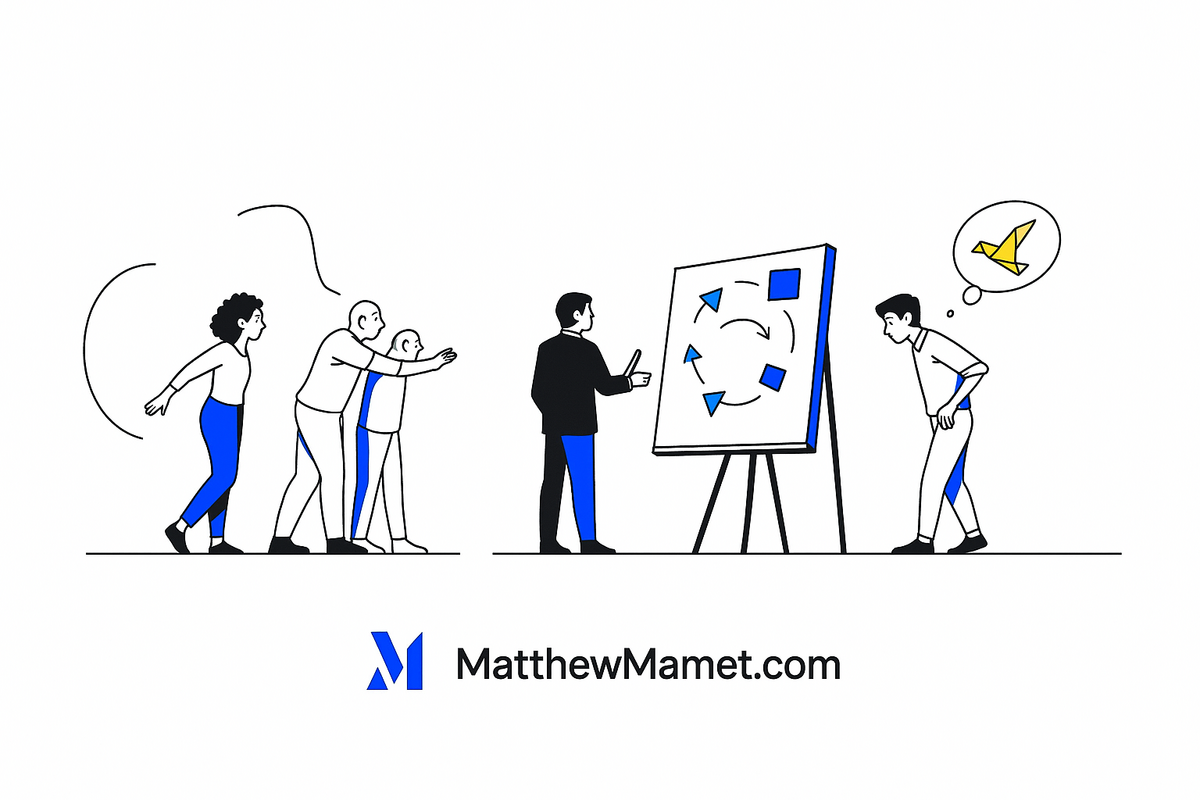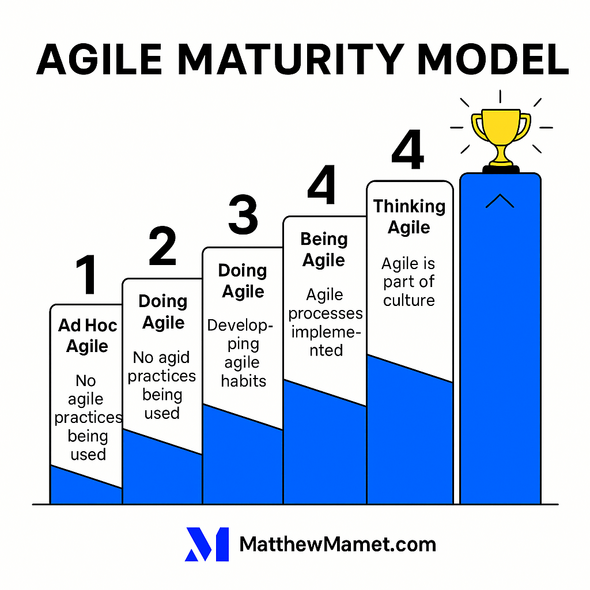Summary:
Agile leadership training is essential for modern businesses, shifting leaders from outdated, rigid management styles to adaptive, empowering approaches. This training equips leaders to foster innovation, guide self-organizing teams, and respond swiftly to market changes. As traditional top-down models become obsolete, agile leadership emphasizes empowerment, psychological safety, and continuous learning, crucial for navigating today's dynamic business environment. Organizations increasingly recognize the need for this transformation, investing significantly in leadership development to enhance team autonomy and drive innovation.
Table of Contents
Agile leadership training is what gets your leaders out of rigid, outdated management habits and into a more adaptive, empowering mindset that modern business demands. It’s about arming them with the skills to spark innovation, guide self-organizing teams, and react quickly when the market shifts. This isn't some niche idea anymore-it's a core business necessity.
Why Traditional Leadership Is Becoming Obsolete
In a business world defined by constant change, the old top-down leadership models are cracking under the pressure. That classic command-and-control structure, once the bedrock of corporate life, is just too slow and inflexible for today's pace. Companies clinging to it often find themselves struggling, easily outmaneuvered by more nimble competitors.
I've seen this play out firsthand. Think of a large retail company that failed to shift its leadership style when e-commerce exploded. Its managers kept dictating every move from the top, completely stifling the creativity of their front-line employees-the very people who saw the market shifts happening in real-time. Their inability to empower teams led to sluggish decision-making and a ton of missed opportunities, ultimately costing them huge chunks of market share.
The Shift to Empowerment and Agility
The truth is, market volatility and new tech demand a completely different kind of leader. This has fueled a massive shift toward more empowering leadership styles. In fact, top-tier organizations have ramped up their empowering leadership training hours by an incredible 171% in recent years. You can discover more about this leadership training surge and what’s driving it. The data points to one thing: an urgent need for leaders who can offer clear guidance, especially when things get uncertain.
Ready to drive more growth & achieve bigger impact?
Leverage my 25+ years of successes and failures to unlock your growth and achieve results you never thought possible.
Get StartedTo really see the difference, it helps to put the two approaches side-by-side. The old way was about directing and controlling resources. The new way is about cultivating potential and enabling teams.
Traditional vs Agile Leadership Approaches
| Characteristic | Traditional Leadership | Agile Leadership |
|---|---|---|
| Decision Making | Top-down, centralized | Decentralized, team-based |
| Focus | Processes and plans | People and value delivery |
| Communication | Formal, hierarchical | Transparent, frequent, informal |
| Team Structure | Siloed, functional | Cross-functional, self-organizing |
| Response to Change | Resistant, follows a rigid plan | Adaptive, embraces change |
| Role of Leader | Director, controller | Coach, facilitator, servant leader |
| Success Metric | Adherence to plan and budget | Customer satisfaction, team morale |
This table makes it clear that the agile approach isn't just a minor tweak; it's a fundamental re-imagining of what a leader does and how they create value.
A leader's primary role in an agile environment is not to have all the answers but to create an ecosystem where the team can find the answers. This means fostering psychological safety, removing impediments, and championing continuous learning.
This shift from controller to enabler is where the real work happens.
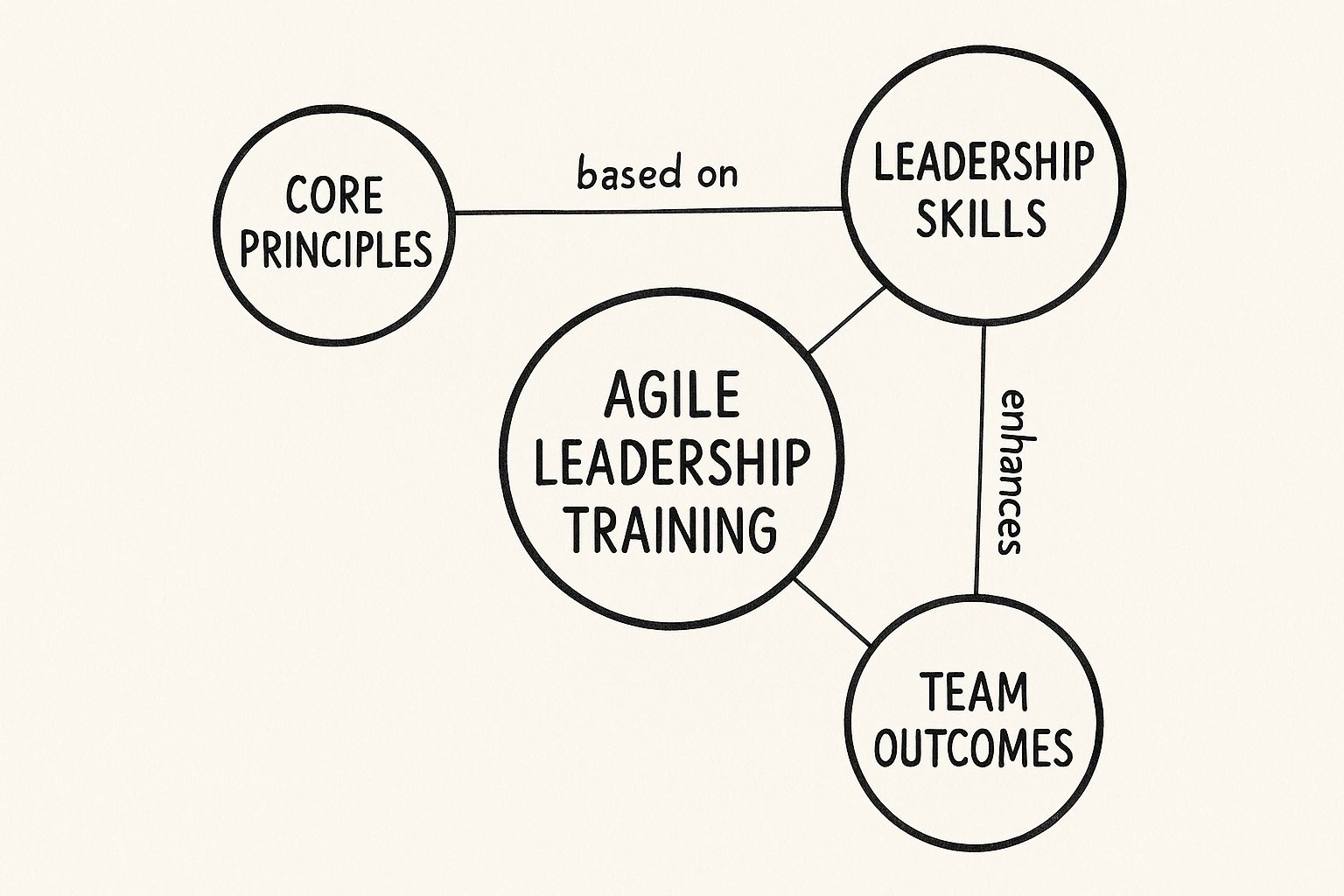
As you can see, the goal isn't just to teach new buzzwords. It's about building a foundation of servant leadership and adaptability that directly produces tangible results, like greater team autonomy and a real capacity for innovation.
From Manager to Enabler
This transition is profound. It’s about moving from a manager who directs work to an enabler who develops people. This approach builds resilience and a true sense of ownership within teams, creating a far more robust and responsive organization.
Ready to drive more growth & achieve bigger impact?
Leverage my 25+ years of successes and failures to unlock your growth and achieve results you never thought possible.
Get StartedFor leaders looking for a flexible way to bring this expertise into their company without a full-time hire, exploring the benefits of a fractional leadership model can be a practical path forward. Ultimately, agile leadership training is the bridge that makes this critical evolution possible.
Diagnosing Your True Leadership Gaps

Before you spend a single dollar on training, you need to get a precise diagnosis. Launching a generic agile leadership program without knowing your specific pain points is like prescribing medicine without understanding the illness. It’s a shot in the dark, and it rarely hits the mark.
The goal here is to move past assumptions and gut feelings. We need to gather real evidence of where your leadership capabilities are actually falling short.
Forget sending out another templated survey that gets you half-hearted, canned responses. Real discovery requires a more hands-on approach. I’ve found time and again that the most valuable insights come from direct, structured conversations and just watching people work-in settings where they feel safe enough to be truly candid.
This focus on developing leaders from within isn't just a "nice to have." It's a strategic necessity. In fact, 83% of businesses now say they are concentrating on building leaders at every single level. It’s a widespread recognition that an adaptable organization is key to staying competitive. You can see more data on employee training trends that back this up, which makes your diagnostic work that much more critical.
Gathering Real-World Evidence
To get an accurate picture, you can't rely on one source of information. You need to triangulate your findings. Each method gives you a different piece of the puzzle, and when you put them together, you get a clear, comprehensive report.
Here are three methods I’ve found incredibly effective:
- Facilitated Focus Groups: Get team leads and individual contributors in a room-without their direct managers present. This is non-negotiable. Guide a conversation around things like decision-making speed, how accessible leadership feels, and what’s actually blocking them from getting work done.
- Candid One-on-One Interviews: Sit down with your senior managers and directors. Ask them pointed questions about their real-world challenges in empowering teams, sparking innovation, and adapting to change. This is where you uncover the cultural and systemic barriers that a survey will never reveal.
- Direct Observation: Be a fly on the wall. Spend time in team meetings, sprint planning sessions, and retrospectives. Watch how leaders interact with their teams. Do they dominate the conversation, or do they facilitate it? Do they jump in to solve problems for the team, or do they coach them toward their own solutions?
Pinpointing Specific Competency Gaps
As you gather all this qualitative data, patterns will start to emerge. Your job is to translate those raw observations into clear, specific competency gaps. You’re moving from a vague note like "needs better communication" to a precise diagnosis like, "Leaders are struggling to give constructive feedback during code reviews, which has created a culture of avoidance."
The difference between a successful agile leadership initiative and a failed one often lies in the quality of the initial diagnosis. Pinpoint the exact behaviors you need to change, and you can design a program that delivers measurable results.
For example, you might uncover deep-seated issues like:
- A consistent lack of servant leadership, where managers are acting more like taskmasters than true enablers.
- An inability to cultivate psychological safety, which leads to teams that are terrified to experiment or admit when they’ve failed.
- A fundamental misunderstanding of how to coach for high performance, with leaders defaulting to just telling people what to do.
This detailed report becomes the blueprint for your entire training program. It ensures that every dollar you invest is targeted with surgical precision for maximum impact.
Designing a Curriculum That Actually Changes Behavior
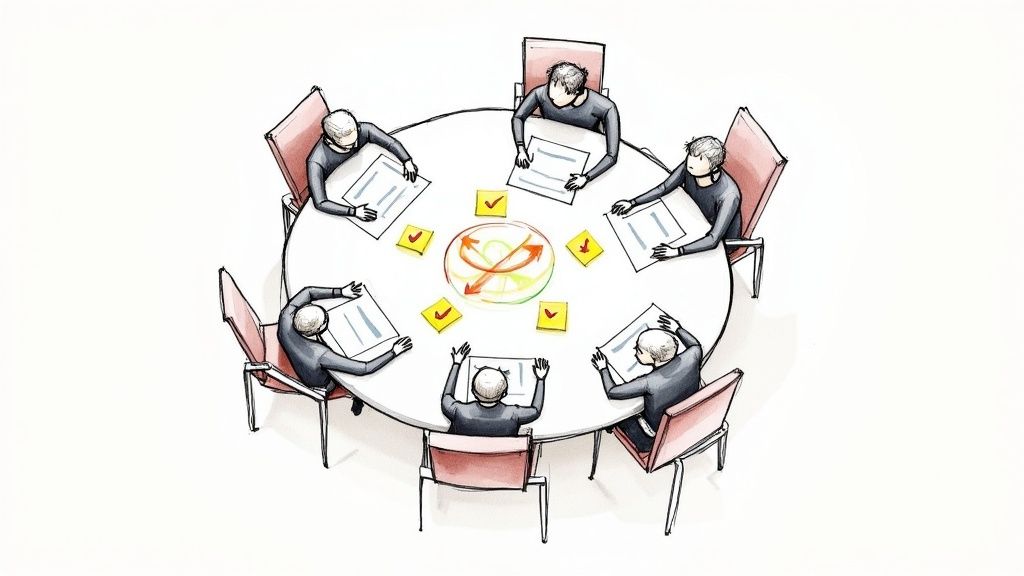
Let's be honest: most leadership training doesn't stick. It’s a series of one-off workshops that feel inspiring for a day and are forgotten by the next. An effective agile leadership program is different. It’s not just a collection of presentations; it's a learning journey designed to reshape habits and build real, lasting capabilities.
The goal is to move beyond theory and get intensely practical. Leaders need tools they can apply the very next day. To do that, we need a blended learning experience that combines interactive sessions, ongoing coaching, and real-world application. This layered approach is what prevents the learning from evaporating the moment the training "officially" ends.
Ready to drive more growth & achieve bigger impact?
Leverage my 25+ years of successes and failures to unlock your growth and achieve results you never thought possible.
Get StartedCore Modules for Lasting Change
Your curriculum needs a solid foundation built on a few critical pillars. These modules tackle the most important mindset shifts required for a leader to thrive in an agile environment. While your own needs assessment will color in the details, any great program has to cover these bases.
- Mastering Servant Leadership: This is the big one-the foundational shift from being a director to an enabler. Activities here aren't about lecturing; they're about practicing active listening, building empathy, and learning to ask powerful questions instead of just dishing out answers.
- Fostering Psychological Safety: You can't have innovation or honest feedback without a safe environment. Leaders need to learn how to model vulnerability, celebrate the lessons that come from failure, and build a culture where people feel secure enough to challenge the status quo.
- Coaching for High Performance: Great leaders develop their people, not just manage their tasks. This module is about unlocking the potential within the team. It’s such a core competency, and you can go deeper into the value of coaching and leadership development for growth.
And in today's world, any modern curriculum must prepare leaders to handle the unique challenges of managing distributed agile teams, which demands a whole different level of communication and collaboration skills.
Making It Stick: Learning by Doing
Generic lectures fall flat. Always. The magic happens when leaders get their hands dirty with practical exercises that feel just like the challenges they face every single day. This is where real behavior change begins.
The most impactful agile leadership training feels less like a classroom and more like a lab. It’s a place for safe experimentation, where leaders can try out new behaviors before they take them live with their teams.
Consider this: agile methods are no longer just for software teams. They're spreading across entire organizations, with 86% of marketers now planning to adopt agile practices. This massive shift means leaders in every department need hands-on experience, not just a high-level overview.
Here are a few examples of exercises that create deep, lasting learning because they're based in reality:
- Role-Playing Difficult Conversations: We set up realistic scenarios where a leader has to give tough feedback or navigate a team conflict. A facilitator is right there to offer immediate coaching on their approach, tone, and language. It's practice in a safe space.
- Mock Value-Stream Mapping: Have leaders facilitate a session to map a real, low-risk internal process. This isn't theoretical-it gives them direct experience in spotting waste and guiding a team toward tangible improvements.
- Peer Coaching Circles: This is crucial for making the learning last. After the initial workshops, we group leaders into small peer circles. They meet regularly to talk through their current challenges, share what's working, and hold each other accountable. It creates a powerful, built-in support system that continues long after the formal training is over.
Choosing Delivery Methods That Reinforce Agility
How you deliver your agile leadership training is just as critical as what you're teaching. If you stand up and lecture for eight hours, you’re sending a message that directly contradicts the very mindset you want to build. The format itself has to be a living, breathing example of agility-interactive, iterative, and dripping with collaboration.
Leaders need to feel agility in their bones, not just hear about it in a slide deck. This means getting them out of passive listening mode and into active participation. The medium truly is the message here. A dynamic training environment shows them what an agile culture actually feels like, making the lessons stick.
Ready to drive more growth & achieve bigger impact?
Leverage my 25+ years of successes and failures to unlock your growth and achieve results you never thought possible.
Get StartedImmersive vs. Virtual Formats
The choice between shipping everyone to a hotel for a week or running a program online isn't just about logistics or budget. It's a strategic decision about the kind of learning experience you want to create. Each format has its own unique power to reinforce agile behaviors.
In-Person Bootcamps: I've seen these multi-day deep dives work wonders. You fully immerse leaders in an agile bubble, away from the daily grind. They’re fantastic for forging deep personal connections and getting hands-on practice with tough skills like facilitation in a high-energy, focused setting. There’s a certain magic to the face-to-face interaction that’s hard to replicate, especially for complex role-playing.
Cohort-Based Virtual Programs: On the flip side, virtual programs offer incredible flexibility and spaced learning, which can be far better for building lasting habits. Leaders learn a concept one week, go apply it in their actual job, and then come back to the group to share what worked and what blew up in their face. This cycle-learn, apply, reflect-is pure agility in action.
Crafting an Experiential Learning Environment
It doesn't matter if you're in a conference room or on a Zoom call. The secret sauce is making it experiential. Leaders shouldn't just hear about agile principles; they have to live them inside the training itself. This is what separates a program people rave about from one they forget by Tuesday.
Here are a few ways I’ve seen this work in the real world:
- Form 'Scrum Teams' for Projects: Right at the kickoff, break participants into small, cross-functional groups. Give them a real, albeit small, project to work on for the duration of the program. They’ll have to manage a backlog, collaborate, and run their own mini-sprints. It forces them to practice what you're preaching, immediately.
- Embrace Collaborative Digital Tools: Use platforms like Miro or Mural as your shared digital workspace. Get leaders working together in real-time to map a customer journey or run a retro. This isn't just a gimmick; it models the kind of transparent, digital-first collaboration they need to lead modern teams.
- Lean into 'Just-in-Time' Learning: Don't be a slave to your agenda. If a particular topic sparks a deep, relevant discussion that wasn't on the schedule, let the group pull on that thread. Run with it. This teaches a core agile competency: how to adapt and respond to the real, immediate needs of the team (or, in this case, the room).
Your training delivery shouldn't just teach agility; it must embody it. When leaders experience iterative work, collaborative problem-solving, and adaptive planning firsthand, the lessons move from theoretical fluff to ingrained behavior.
When you intentionally design the training experience to mirror the agile values of transparency, collaboration, and adaptation, you dramatically increase the odds that these new leadership behaviors will actually show up back in the real world.
Proving The Business Value Of Your Program
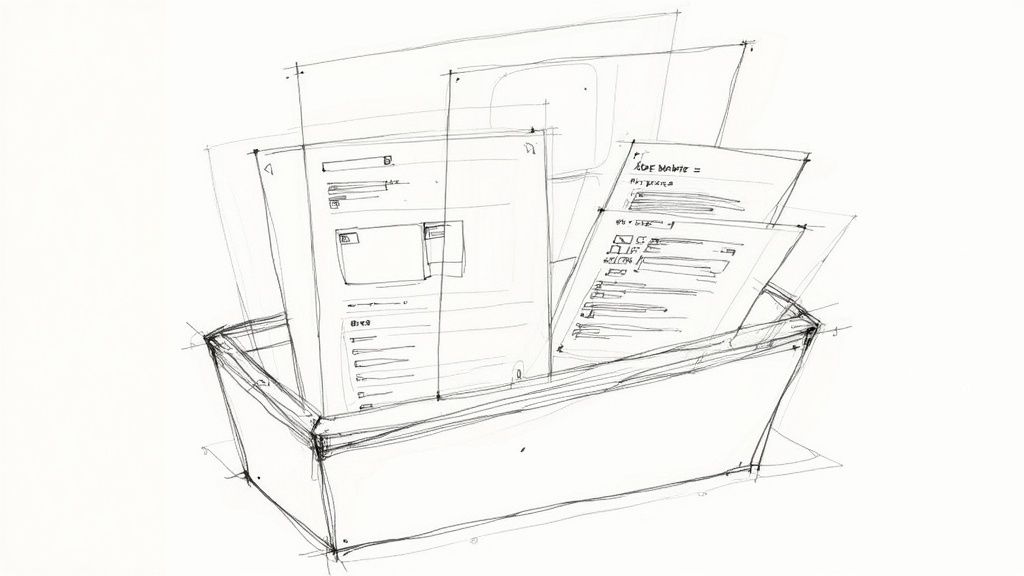
Investing in agile leadership training feels right, but that feeling won't get next year's budget approved. To justify the investment and build real momentum, you have to prove its worth with cold, hard data. Stakeholders need to see a clear return on their investment, which means going far beyond the typical "smile sheets" that only tell you if people enjoyed the free coffee.
The real goal here is to draw a straight line from the new leadership behaviors you're teaching to tangible improvements in business outcomes. This isn’t a single-threaded effort. You need to measure changes in team performance and track specific shifts in how your leaders behave. You have to show that the training didn't just happen-it actually worked.
Ready to drive more growth & achieve bigger impact?
Leverage my 25+ years of successes and failures to unlock your growth and achieve results you never thought possible.
Get StartedMeasuring Tangible Performance Metrics
This is where the rubber meets the road. Agile teams are a goldmine of data that can serve as powerful signals of leadership effectiveness. The trick is to get a clean baseline of these metrics before the training kicks off. Then, you track them consistently afterward to show a clear trend line.
I always tell people to focus on the metrics that directly reflect how well the team delivers value. These are the numbers executives understand and care about.
- Cycle Time: How long does it take for a work item to get from "in progress" to "done"? Great agile leaders are masters at removing impediments. When you see cycle time dropping, it's strong evidence that your leaders are getting better at clearing the path for their teams.
- Release Frequency: How often is the team shipping valuable stuff to customers? As leaders learn to empower their teams and foster real collaboration, you should see an uptick in how often they can release new features or updates.
- Team Velocity or Throughput: While velocity can be a loaded term, a stable or increasing trend shows a team is becoming more predictable and consistent. That's a hallmark of a well-supported, high-performing team.
Don’t just present the numbers; tell the story behind them. A 20% reduction in cycle time isn't just a stat. It means your leaders are getting better at unblocking their teams, which translates directly to faster value delivery.
Quantifying Behavioral Shifts
Measuring behavior change can feel fuzzier than hard performance data, but it's just as critical. This is how you prove the lessons from the training room are actually being applied on the job. The best tool I've found for this is a targeted 360-degree feedback assessment.
But this can't be your standard-issue performance review. It needs to be custom-built around the specific competencies you taught in the agile leadership program. For instance, you could measure perceived improvements in areas like:
- Creating psychological safety.
- Delegating decisions effectively.
- Coaching team members instead of just directing them.
- Facilitating productive retrospectives.
By running this assessment before the program and again about six months later, you can gather real, quantitative data on behavioral change. Seeing a leader’s score in "Coaching for High Performance" jump from a 2.5 to a 4.1 is powerful proof of individual growth.
To give you a clearer picture, here’s a look at the types of metrics you should be tracking.
Key Metrics for Measuring Training Impact
| Metric Category | Specific Metric | Measurement Method |
|---|---|---|
| Team Performance | Cycle Time | Jira/Azure DevOps data (pre vs. post-training) |
| Team Performance | Release Frequency | Deployment logs (pre vs. post-training) |
| Team Performance | Team Throughput | Agile management tool data (pre vs. post-training) |
| Leader Behavior | Coaching & Mentoring | 360-degree feedback surveys (pre vs. post-training) |
| Leader Behavior | Psychological Safety | Anonymous team surveys |
| Leader Behavior | Employee Engagement | Annual/pulse engagement scores |
| Business Impact | Employee Retention | Attrition rates for teams with trained leaders |
| Business Impact | Product/Service Quality | Defect rates or customer satisfaction scores (CSAT) |
Tracking these metrics gives you a holistic view. You're not just looking at one piece of the puzzle; you're seeing the whole picture.
When you combine these people-centric insights with hard performance data, you create a business case that’s almost impossible to argue with. At the end of the day, leadership development is meant to drive measurable outcomes, much like effective document workflow management strategies are meant to streamline operations.
This data-backed approach shows exactly how better leadership fuels team autonomy, sparks innovation, and boosts the bottom line. For anyone serious about growing in this area, having a solid grasp of the core technical leadership skills is the perfect foundation for this journey.
Common Questions on Agile Leadership Training
Even when the benefits seem clear, jumping into agile leadership training usually comes with a lot of practical questions. And a healthy dose of skepticism. It's only natural. Leaders want to know how this new way of working will actually fit into their world and what kind of real-world headaches to expect.
Getting these concerns out on the table is the first step. You have to address them head-on if you want to build the confidence to move forward.
Ready to drive more growth & achieve bigger impact?
Leverage my 25+ years of successes and failures to unlock your growth and achieve results you never thought possible.
Get StartedOne of the first questions I always hear is, "Do we have to go 'full agile' across the whole company for this to work?" The answer is a hard no. The core ideas of this leadership style-empowering people, being transparent, and serving the team-are valuable in any business structure. I’ve seen many organizations use agile leadership training as a powerful first step to fix team dynamics and make their leaders more effective, long before they even think about a full-scale transformation. Sometimes, it's all they need.
Navigating the Inevitable Challenges
Another big worry is the rollout itself. The single biggest challenge leaders run into, almost without fail, is cultural resistance. This is especially true for managers who are deeply rooted in a traditional, command-and-control mindset. When you ask them to shift from being a director to an enabler, it can feel like a loss of authority or control. That’s unsettling for anyone.
To get past this, you have to be strategic. Your implementation plan needs to anticipate this friction. Here's what's essential:
- Get strong executive sponsorship: The message that this is a priority has to come from the very top. No exceptions.
- Be crystal clear on the "why": Leaders need to buy into the business reasons behind the shift, not just the mechanics of a new process. What problem are we actually trying to solve?
- Showcase early wins: Find a pilot team, help them succeed, and then shout it from the rooftops. Success builds credibility and momentum faster than any slide deck.
The training can't just be theoretical. It has to be experiential, letting managers practice these new habits and confront their fears in a safe environment. They need to feel how this new approach can be more effective, not just be told that it is.
The most fundamental difference between agile leadership and traditional project management is its purpose. Traditional management is about controlling variables-scope, schedule, and budget. Agile leadership is about unleashing potential. It's about empowering teams to self-organize, removing obstacles for them, and coaching them toward growth.
Finding the Right Training and Resources
The final, practical question is usually some version of, "Okay, where do we even start?" It's one thing to understand the principles, but finding a structured program to guide your leaders can feel like a huge task. The key is to find a curriculum that actually maps to your organization's specific needs and leadership gaps.
If you're looking for a solid example of what a high-quality program looks like, a great starting point is Dalm's Digital Agile Leadership Masterclass. Seeing what's out there helps you compare different approaches and find a path that fits your goals. The right training provides more than just information; it creates a supportive space for leaders to genuinely practice and internalize these new skills and mindsets.
Are you a software or product executive ready to drive real growth and cultivate a high-performing team? Matthew Mamet offers personalized coaching and strategic roadmaps to help you master the art of modern leadership. With over 25 years of experience scaling businesses, Matthew provides the practical playbooks and mentorship needed to turn your leadership potential into measurable results.
Book a discovery call with Matthew today to start your journey.
Ready to drive more growth & achieve bigger impact?
Leverage my 25+ years of successes and failures to unlock your growth and achieve results you never thought possible.
Get Started

